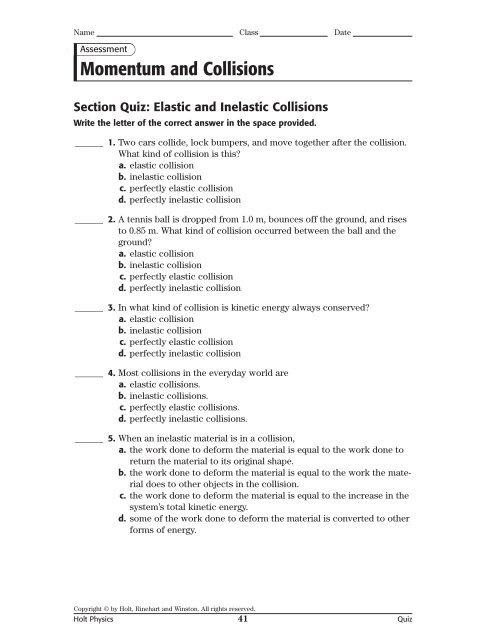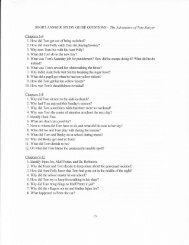Momentum and Collisions - Fort Thomas Independent Schools
Momentum and Collisions - Fort Thomas Independent Schools
Momentum and Collisions - Fort Thomas Independent Schools
You also want an ePaper? Increase the reach of your titles
YUMPU automatically turns print PDFs into web optimized ePapers that Google loves.
Name Class Date<br />
Assessment<br />
<strong>Momentum</strong> <strong>and</strong> <strong>Collisions</strong><br />
Section Quiz: Elastic <strong>and</strong> Inelastic <strong>Collisions</strong><br />
Write the letter of the correct answer in the space provided.<br />
______<br />
______<br />
______<br />
______<br />
______<br />
1. Two cars collide, lock bumpers, <strong>and</strong> move together after the collision.<br />
What kind of collision is this<br />
a. elastic collision<br />
b. inelastic collision<br />
c. perfectly elastic collision<br />
d. perfectly inelastic collision<br />
2. A tennis ball is dropped from 1.0 m, bounces off the ground, <strong>and</strong> rises<br />
to 0.85 m. What kind of collision occurred between the ball <strong>and</strong> the<br />
ground<br />
a. elastic collision<br />
b. inelastic collision<br />
c. perfectly elastic collision<br />
d. perfectly inelastic collision<br />
3. In what kind of collision is kinetic energy always conserved<br />
a. elastic collision<br />
b. inelastic collision<br />
c. perfectly elastic collision<br />
d. perfectly inelastic collision<br />
4. Most collisions in the everyday world are<br />
a. elastic collisions.<br />
b. inelastic collisions.<br />
c. perfectly elastic collisions.<br />
d. perfectly inelastic collisions.<br />
5. When an inelastic material is in a collision,<br />
a. the work done to deform the material is equal to the work done to<br />
return the material to its original shape.<br />
b. the work done to deform the material is equal to the work the material<br />
does to other objects in the collision.<br />
c. the work done to deform the material is equal to the increase in the<br />
system’s total kinetic energy.<br />
d. some of the work done to deform the material is converted to other<br />
forms of energy.<br />
Copyright © by Holt, Rinehart <strong>and</strong> Winston. All rights reserved.<br />
Holt Physics 41 Quiz
Name Class Date<br />
<strong>Momentum</strong> <strong>and</strong> <strong>Collisions</strong> continued<br />
______<br />
______<br />
______<br />
6. A helium atom collides with another helium atom in an elastic<br />
collision. Which of the following is true<br />
a. Both momentum <strong>and</strong> kinetic energy are conserved.<br />
b. <strong>Momentum</strong> is conserved but kinetic energy is not conserved.<br />
c. Kinetic energy is conserved but momentum is not conserved.<br />
d. Neither momentum nor kinetic energy is conserved.<br />
7. Two playground balls collide in an inelastic collision. Which of the<br />
following is true<br />
a. Both momentum <strong>and</strong> kinetic energy are conserved.<br />
b. <strong>Momentum</strong> is conserved, but kinetic energy is not conserved.<br />
c. Kinetic energy is conserved, but momentum is not conserved.<br />
d. Neither momentum nor kinetic energy is conserved.<br />
8. Which of the following is not evidence that kinetic energy has been<br />
lost in a collision<br />
a. The collision produces a sound.<br />
b. At least one of the objects is deformed after the collision.<br />
c. At least one of the objects increases in temperature as a result of<br />
the collision.<br />
d. One of the objects is at rest after the collision.<br />
9. Explain the difference between inelastic <strong>and</strong> perfectly inelastic collisions.<br />
10. A 0.16 kg billiard ball moving to the right at 1.2 m/s has a head-on elastic<br />
collision with another ball of equal mass moving to the left at 0.85 m/s. The<br />
first ball moves to the left at 0.85 m/s after the collision. Find the velocity of<br />
the second ball after the collision, <strong>and</strong> verify your answer by calculating the<br />
total kinetic energy before <strong>and</strong> after the collision.<br />
Copyright © by Holt, Rinehart <strong>and</strong> Winston. All rights reserved.<br />
Holt Physics 42 Quiz















